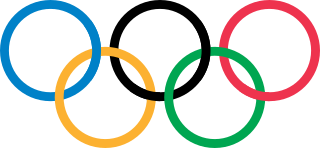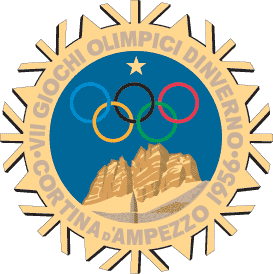
Slalom is an alpine skiing and alpine snowboarding discipline, involving skiing between poles or gates. These are spaced more closely than those in giant slalom, super giant slalom and downhill, necessitating quicker and shorter turns. Internationally, the sport is contested at the FIS Alpine World Ski Championships, and at the Olympic Winter Games.

The Winter Olympic Games is a major international multi-sport event held once every four years for sports practiced on snow and ice. The first Winter Olympic Games, the 1924 Winter Olympics, were held in Chamonix, France. The modern Olympic Games were inspired by the ancient Olympic Games, which were held in Olympia, Greece, from the 8th century BC to the 4th century AD. Baron Pierre de Coubertin founded the International Olympic Committee (IOC) in 1894, leading to the first modern Summer Olympic Games in Athens, Greece in 1896. The IOC is the governing body of the Olympic Movement, with the Olympic Charter defining its structure and authority.

The 1952 Winter Olympics, officially known as the VI Olympic Winter Games and commonly known as Oslo 1952, was a winter multi-sport event held from 14 to 25 February 1952 in Oslo, the capital of Norway.

The 1956 Winter Olympics, officially known as the VII Olympic Winter Games and commonly known as Cortina d'Ampezzo 1956, was a multi-sport event held in Cortina d'Ampezzo, Italy, from 26 January to 5 February 1956.
The 1952 Winter Olympics, officially known as the VI Olympic Winter Games, took place in Oslo, Norway, from 14 to 25 February 1952. A total of 694 athletes representing 30 National Olympic Committees (NOCs) participated in the Games, taking part in 22 events from 6 sports.

Australia sent a delegation to compete at the 1952 Winter Olympics from the 14 to 25 February 1952 in Oslo, Norway. This was the nation's second appearance at the Winter Olympic Games with their last appearance being in 1936.

Korketrekkeren is a tobogganing track and former bobsleigh and luge track in Oslo, Norway. The tobogganing track runs between Frognerseteren and Midtstuen and is operated as a public venue by the municipality. Return transport to the top of the hill is undertaken by riding the Oslo Metro's Holmenkollen Line. Tobogganing in the area started in the 1880s, with several roads being used during winter evenings. Auto racing took place in the hill in 1921 and the following year it saw its first luge tournament. The first major tournament was the FIL European Luge Championships 1937. Tobagganing also took place in the nearby Heftyebakken, but from 1950 Korketrekkeren became the sole tobogganing hill and Heftyebakken was used for cross-country skiing.
At the 1952 Winter Olympics in Oslo, Norway, the six alpine skiing events were held from Thursday, 14 February, to Wednesday, 20 February. The downhill and giant slalom events were held at Norefjell in Krødsherad, Buskerud, and the slalom events at Rødkleiva in Oslo.

Norway was the host nation for the 1952 Winter Olympics in Oslo.

Switzerland competed at the 1952 Winter Olympics in Oslo, Norway.

Finland competed at the 1952 Winter Olympics in Oslo, Norway.

The Philippines sent a delegation to compete at the 1992 Winter Olympics in Albertville, France from 8–23 February 1992. This was the nation's third appearance at the Winter Olympic Games. The delegation consisted of a single athlete, alpine skier Michael Teruel. He competed in both the giant slalom, where he finished in 71st, and in the slalom, in which he finished in 49th.

Lebanon sent a delegation to compete at the 1952 Winter Olympics in Oslo, Norway from 14 to 25 February 1952. This was the country's second time competing in a Winter Olympic Games, after their first appearance four years prior. Lebanon was represented in these Olympics by a single alpine skier, Ibrahim Geagea. He competed in three events, and his best finish was 57th in the men's downhill competition.

Lillehammer Olympic Bobsleigh and Luge Track is a bobsleigh, luge and skeleton track located at Hunderfossen in Lillehammer, Norway, 15 kilometers (9 mi) north of the town center of Lillehammer. It was completed in 1992 for the 1994 Winter Olympics, where it hosted the bobsleigh events and luge events. It has since also hosted the FIBT World Championships 1995 in skeleton and the FIL World Luge Championships 1995, and hosted 2016 Winter Youth Olympics.

Rødkleiva is a hill located in Nordmarka in Oslo, Norway. It was taken into use as a slalom hill in 1947 and was used for the combined event of the Holmenkollen Ski Festival eleven times between 1947 and 1963. It hosted the slalom events for the 1952 Winter Olympics, which saw a crowd of at least 25,000 spectators. The Olympic course was 422.5 meters (1,386 ft) long and had a drop of 169 meters (554 ft). The course gradually fell into disrepair and was closed in 1988.

The 1952 Winter Olympics were held in and around Oslo, Norway, from 14 to 25 February 1952. Ten competition and eight non-competition venues were used, in addition to three designated, but unused, reserve competition venues. Six of the competition venues were located in Oslo, while one each was located in Bærum, Skedsmo, Drammen and Krødsherad. Bislett stadion was the centerpiece of the games, hosting the opening and closing ceremonies, the speed skating and the figure skating. Bislett featured both a 400-meter (1,300 ft) circumference speed skating track and a 60-meter (200 ft) long rink used for figure skating, separated by snow banks. Two reserve venues were designated for the skating events, Tryvann stadion in Oslo and Hamar stadion in Hamar.

A women's slalom event was held at the 1952 Winter Olympics in Oslo, Norway as part of the alpine skiing programme.
Antoin Miliordos was a Greek alpine skier who represented his nation at the Winter Olympic Games.

Norefjell Ski Resort is a mountain ski resort located in Krødsherad, Norway, on the mountainside of Norefjell. The venue for four Olympic alpine skiing events in 1952, it is located northwest of Oslo, 90 minutes away by vehicle.















